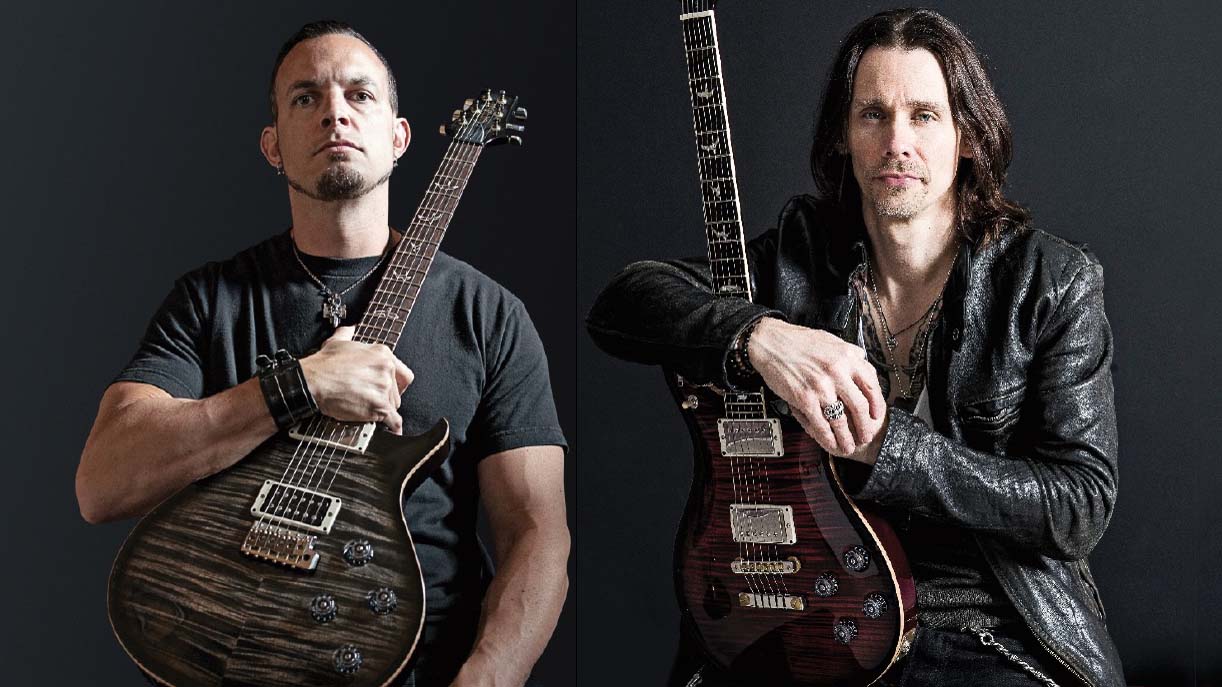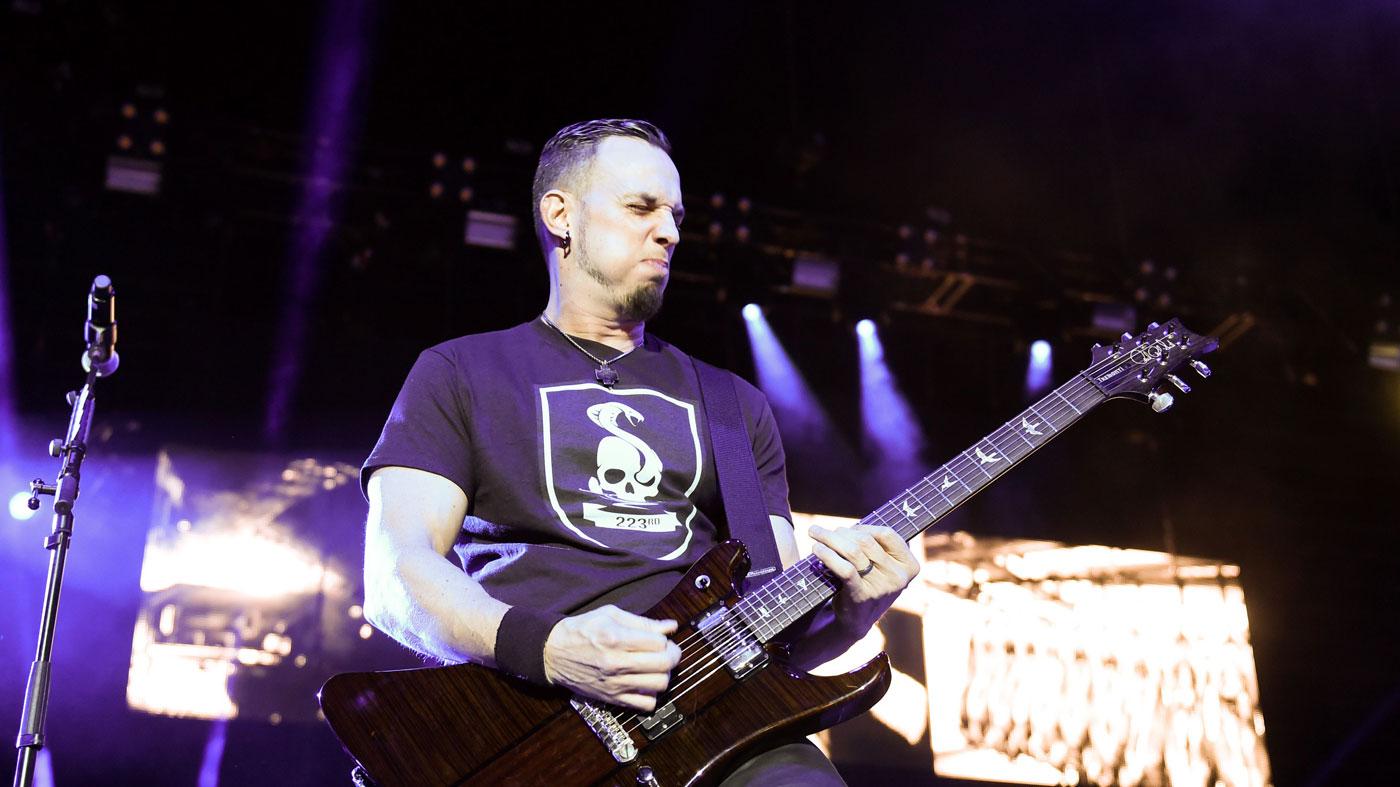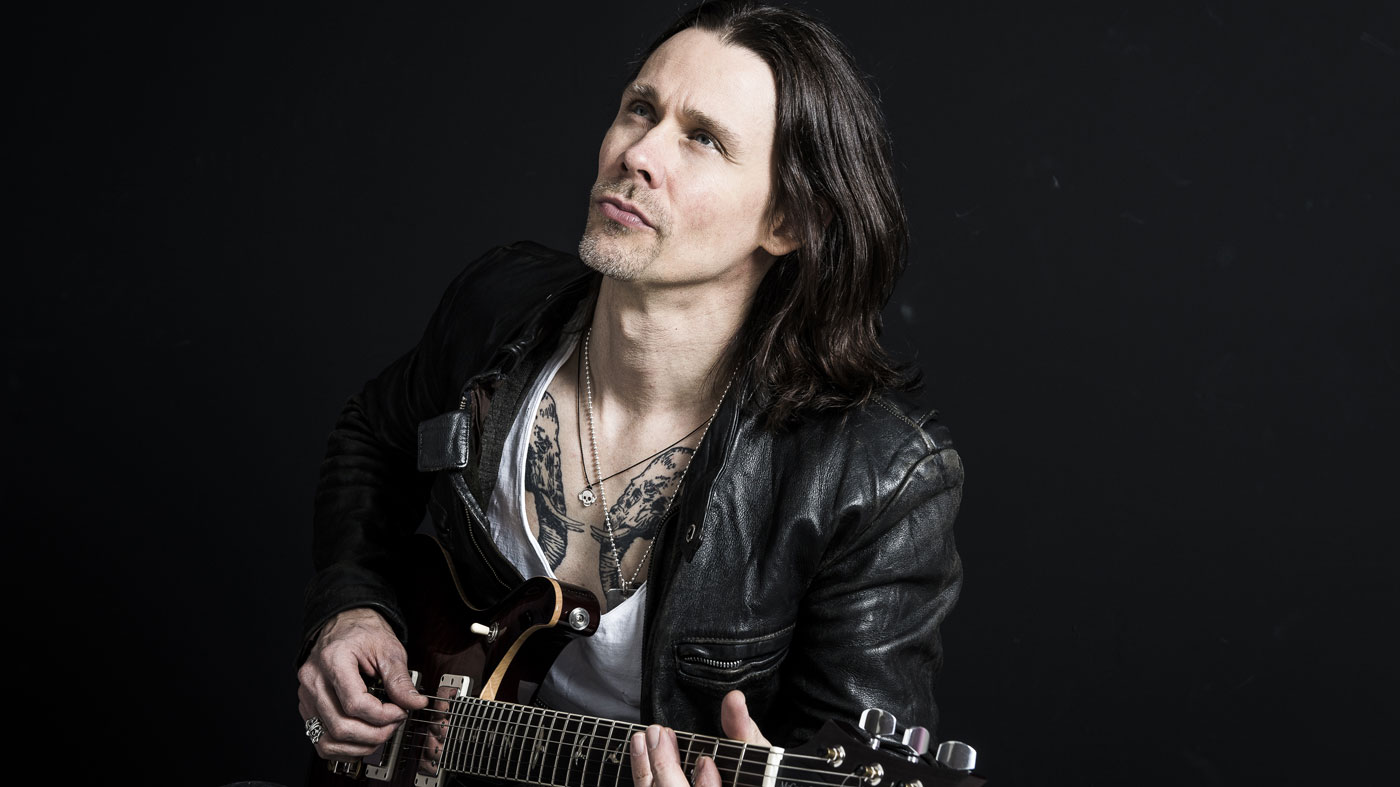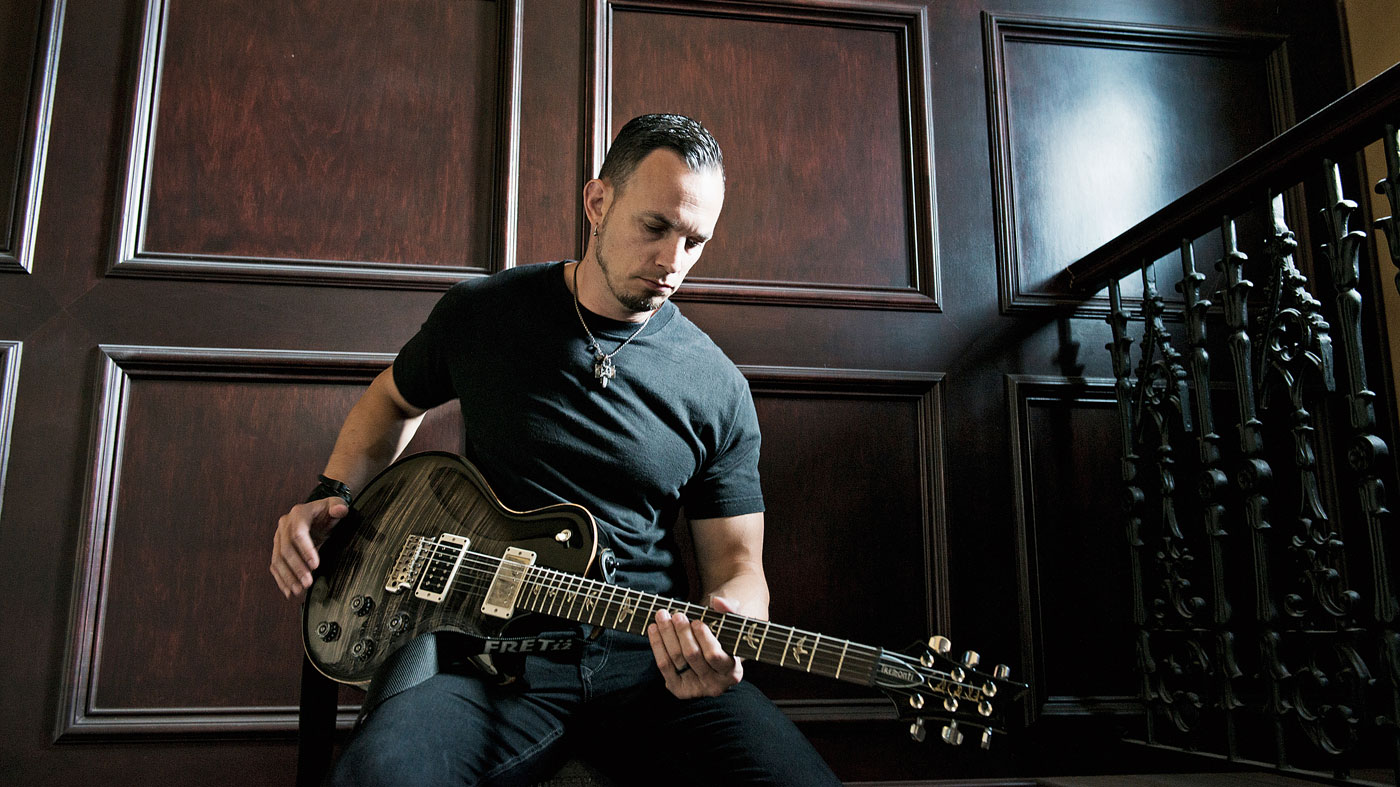Alter Bridge talk fresh solos and the move to seven-strings for The Last Hero
Mark Tremonti and Myles Kennedy talk

Introduction
Alter Bridge’s new album finds Mark Tremonti and Myles Kennedy not just hitting new heights with their solos, but the way they work together, too. We take a look inside their creative process…
Alter Bridge have a huge UK arena tour looming on the horizon - a massive achievement for any heavy rock band
It’s 12 years since they first started writing together, and Myles Kennedy and Mark Tremonti now find themselves in an unusual position. Despite their lack of mainstream recognition, Alter Bridge have a huge UK arena tour looming on the horizon.
It’s a massive achievement for any heavy rock band in these times, and an intensely dedicated work ethic and hugely loyal fanbase have carried them far. But if you really want to understand the key to Alter Bridge’s success, you need to lift the lid on how Tremonti and Kennedy create their songs as a team. Because that’s where the real magic happens. “When it works, those are the moments that show us why we do this,” marvels Mark.
“Those are the most rewarding parts and they when we put our parts together, it makes what I’ve done on my own twice as good.” Myles concurs, “It makes each person feel part of the song. It’s truly collaborative.”
Though new album, The Last Hero, takes a look at the nature of heroism and leadership, even more fittingly for us, there’s plenty of guitar heroics going on as both players step up to new levels as lead players on some huge anthemic songs. But musicians can learn just as much from the way the pair work as a team to craft their albums…
Don't Miss
Myles Kennedy and Mark Tremonti talk Alter Bridge's The Last Hero track-by-track
Mark Tremonti: the 14 records that changed my life

We could be heroes
When did the heroes and leaders theme come into the writing process for these songs?
At the end of the day I’m just hoping for inspiration. There is nothing harder than trying to write a lyric when there’s no inspiration
Myles Kennedy: “Very early. Because it was written in a relatively short period of time and the initial volume of what was going on in the world around us was so amplified, it was hard to avoid it and so the concept of leaders and heroes, how that plays an integral part of our world as human beings was weighing pretty heavily on me in particular. I’d been thinking about that a lot so it definitely manifested itself in the songwriting process.”
Does it help you focus when there is an ongoing theme at the back of your mind or can it also be an obstacle?
Myles: “At the end of the day I’m just hoping for inspiration. Because, let me tell you, there is nothing harder than trying to write a lyric when there’s no inspiration. When the well is dry and you’re trying to come up with something it’s such an arduous process.
"This was probably the fastest, easiest lyric on a record I’ve ever experienced and in a way it helped my guitar playing because lyrics were done so early on in the process, it allowed me to spend time working on solos. Which I never used to do. I used to just wing it because I was so far behind with the lyric process.”

Fusion fun
The title track and This Side Of Fate are two examples of solos where we’re hearing more of your fusion roots coming through…
Ever since I heard how good a guitar player Myles was, I’ve been really pushing him to do more
Myles: “I think you can definitely hear that at times. A lot of passing tones and a lot of chromatic runs. Some of that is the jazz language, some of that is listening to Steve Morse early on. The chromatic runs are something I think I got from him. And my friend Ian Thornley [Big Wreck], he does that quite a bit. So I thought I’ll throw a little bit of that in.”
Mark Tremonti: “He’s doing more and more soloing and from day one, ever since I heard how good a guitar player he was, I’ve been really pushing him to do more of this because it would be a damned shame as good as he is not to showcase that talent.”
Myles: “Elvis [Baskette, producer] and Mark were pushing me to do more of it. Generally I’ve been kind of hesitant because I like the idea that I sing for two thirds of the song and Marks takes over on a solo. I’m always thinking of a live context and how it takes attention off a person and I just think it keeps it interesting. But at the same time I do love playing lead guitar. As you know, it was how I started. And I really enjoyed the process on this record.”

Solo scenarios
What were your goals on this album, as guitar players – did you come into the sessions wanting to emphasise or focus on anything new?
Myles: “It’s funny, I’ve been the same way for years. Instead of focussing on other people’s licks and vocabulary, which can be really helpful and I used to do that a ton probably for the first decade of playing, I really get off on creating my own lines and creating shapes and patterns and getting them to where they’re just automatic.
I’d just got done writing 18 guitar solos for the Tremonti records and I was thinking, ‘I hope I have enough ideas to keep going!'
“And I think a lot of that comes from years of jazz study and seeing how a lot of the jazz cats would do that. So when I look at the neck I see all this potential – I see the chord tones, scales and passing tones and I want to come up with interesting fun ways of playing those that can be uniquely my own.”
Mark: “I just came in knowing I had to write a whole bunch of solos and hoping I could do it. I’d just got done writing 18 guitar solos for the Tremonti records and I was thinking, ‘I sure hope I have enough ideas to keep going forward on the 11 or 12 solos I put on this album!’
“I always try to have a vocal approach when if you took every solo out of its song and played it by itself, it would stand alone as a composition. I love it when you can reintroduce the vocal melodies in parts of the solos and build off of that here and there. I love hitting the chord changes and for there to be a beginning, middle and end to every solo just like there is in every song. I don’t like it to be just a collection of repetitive riffs that are there for the sake of being there.
“I like to have as much emotion as possible. And when I can’t find that emotion in the solo, a lot of times I’ll say, ‘Hey Myles how do you feel about this solo section? Do you want to do it?’ And he’ll jump right on it. Like the Crows On A Wire solo, I wasn’t feeling that at all. And he did a great job.”

Eight days a week
You put together songs quickly, but the solos suggest you’ve had the time to give each approach careful consideration. What’s your solo writing process?
Mark: “I just know as soon as the pre-production is done and I know what the target is, I will not stop until they’re done. Sometimes it will take me a week, sometimes it will take me a night. If I can finish one solo in one night I’m the happiest guy in the world.
I'll play over a solo maybe 150 times, recording it every time and seeing if there’s a piece I want to make work
“It will probably take me on average three days to put together a solo. But that’s with the kids going to bed at nine o’clock and me up until four in the morning every day. That’s with me playing over it maybe 150 times, recording it every time and seeing if there’s a piece I want to make work. The hardest part for me is how does it begin. Once I have that beginning down it flows much easier for me because then when I improvise over it I’ll start the same way then see where it takes me.
“If I come up with something cool then I’ve got the first couple of parts. A lot of times I’ll have the beginning and the ending first, or the beginning and where it repeats the chord progression now. Then I’ve got to fill in the other parts. In the studio sometimes I’ll fall off the rails into something else that’s cooler and improvised that works. Because sometimes improvised solos have a certain magic that you can’t repeat.”
Your writing process together is also unique. Mark catalogues his ideas and files them individually as intros, verses, mid sections and so on. Do you do the same ahead of meeting for Alter Bridge writing sessions, Myles?
Myles: “That’s the exact system we both use. Initially that was kind of a new concept because I would write songs and try to get the entire thing done in a very specific period of time, which I still do and believe in that approach, but with Alter Bridge this is the way we do things where we’re both stockpiling ideas and organising the ideas or separate files where you’ve got your bridges, separate choruses, verses and intros. Then knowing when you get together with your writing partner you’re going to try and marry your individual parts as opposed to coming in with an entire body of work done.”

Puzzle pieces
How do you make these individual ideas fit together so seamlessly?
Myles: “It’s fascinating. This Side Of Fate is a perfect example. Mark had that fingerpicked verse and chorus and then I had worked up this very orchestrated thing that was very Queen-inspired. But all I would have to do was change my tuning, or tweak a little thing here and there to marry it. But I think that was the first or second skeleton of a song that we put together, while we were Skyping actually.”
I still don’t understand why one melody seems to give you goosebumps vs another that doesn’t
Mark: “If you have to change the tempo a little or the tuning, you just try to make it work as best as you can. It’s heartbreaking when you can’t fit a part you thought would work so well with a song. But maybe it’s just too damned slow or fast and it just ruins the vibe of the song.”
The mid sections are a real strong point in your songs – especially Cradle To The Grave and Twilight. They can be a tricky thing for songwriters after the verses and choruses are written. Does your unique process help?
Myles: “Yes, and that’s the benefit of this approach to writing. Because it’s all about perspective. So if you stockpiled all of these bridges and you’re listening with your partner and presenting all of these ideas and you react… and it’s a weird primal thing, especially with melodies.
“I don’t understand why one melody seems to give you goosebumps vs another that doesn’t. They’ll probably design some computer programme to figure that out some day but right now it’s very mysterious – and that’s awesome. So when you stockpile ideas you go back and listen with a fresh perspective, like the listener would, as opposed to if you’ve just come up with a part and you’re thinking, we’ve got to have a middle eight here so let’s just write a part. It doesn’t have time to sit like a fine wine [laughs]. It’s all about that perspective.”
Mark: “We’ve always tried our hardest to make that bridge the best part of the song. Luckily we’ve had a lot of great moments but a lot of times it happens in the moment for us, too. Bridges have been the peak of the energy of the song a lot of the time – a huge payoff. When I hear a song and I turn it on I don’t want to just look forward to the chorus every time. I want to wait to hear this part, a part that only happens once. Then maybe the riff comes back towards the end. I like that you have something to look forwards to deep within the song. A lot of the times that’s the best part of the song.”

Alternate rock
Alternate tunings are also an integral part of keeping the songwriting process fresh and inspired. Did you bring any new ones in this time?
Myles: “For Cradle To The Grave I used a new tuning I’d always wanted to try. It’s basically Open G down a half step but turning it into a G minor tuning - so you take the B and drop it down half a step to a minor third. And I like that tuning, I think that’s a lot of fun.”
I always think it’s a fun challenge to play in a new tuning and have to write a solo with it
Mark: “I used DADGAD for the first time on Twilight. I always think it’s a fun challenge to play in a new tuning and have to write a solo with it. People ask, ‘Doesn’t that drive you crazy?’ But it’s the best gift in the world because you’re not repeating yourself ever. You’re not going to repeat someone else’s licks yet because you don’t have an idea of what the hell you’re doing in the first place. And that’s where you find the magic.”
“My Champion also has a new tuning for this record. It’s half step down and the low string is tuned to C [B G# C# F# A# D#]. I really liked that riff because I could use a lot of the open strings and it had kind of 70s vibe that I dug. Then there’s another tuning that I still need to figure out what it is because I do it by ear.
“On This Side Of Fate I use a tuning that I’ve never used before and it’s a really great exciting one. I’ve written a lot of ideas in it but it’s just that only one made this record. That finger picked part in This Side Of Fate is one of the first things that surfaced from that tuning.”

Another string to the bow
And Show Me A Leader marks the first time you’ve used a seven-string on an Alter Bridge record…
Mark: “Yes, I remember getting on the phone with Myles and as usual we have this discussion where we have to decide how we’re going to make this record a little different than what we’ve done in the past, keep on developing and going deeper into the rabbit hole.
I said that one thing I want to do is try to incorporate a seven-string because it’s never been my thing before
“I said that one thing I want to do is try to incorporate a seven-string because it’s never been my thing and it’s never been something that has really inspired me that much. But I want to break it back out and see if I can find some inspiration there. Then Myles showed me the part of the intro for Show Me A Leader and I started playing the seven-string over it. It just added so much depth. Such a big low end and something we haven’t had… we’ve had drop B stuff but this was even heavier sounding. Deeper sounding.
“When we play the song at soundcheck, when you hit that big F# chord – or whatever it’s tuned down to, in normal tuning it would be F# – it’s so big and different. That’s what I love about it, just introducing new musical flavours to what we do in the band over the years.”
What’s the adjustment to seven-string been like for you?
Mark: “I’m still in the baby stages of learning how to get the most out of it. But I’m approaching as if it’s a normal tuned guitar, it’s just got that extra string on the bottom. I still play like it’s in standard tuning but eventually I want to start going crazy with alternate tunings on that thing and keep developing. But that’s the one thing that keeps me away from spending too much time on it.
“That extra string messes with me when it comes to coming up with alternate tunings. It’s just that extra string that makes it more confusing once you go off the path. I’ve become really comfortable with going off the beaten path, coming up with alternate tunings and finding my way around. But when you add that seventh string it’s not my comfort zone. So I’ll have to do it in small doses and see if I can come up with something great.”
Don't Miss
Myles Kennedy and Mark Tremonti talk Alter Bridge's The Last Hero track-by-track
Mark Tremonti: the 14 records that changed my life

Rob is the Reviews Editor for GuitarWorld.com and MusicRadar guitars, so spends most of his waking hours (and beyond) thinking about and trying the latest gear while making sure our reviews team is giving you thorough and honest tests of it. He's worked for guitar mags and sites as a writer and editor for nearly 20 years but still winces at the thought of restringing anything with a Floyd Rose.

